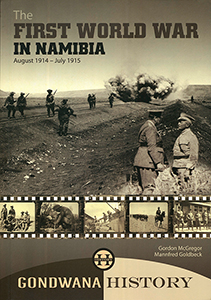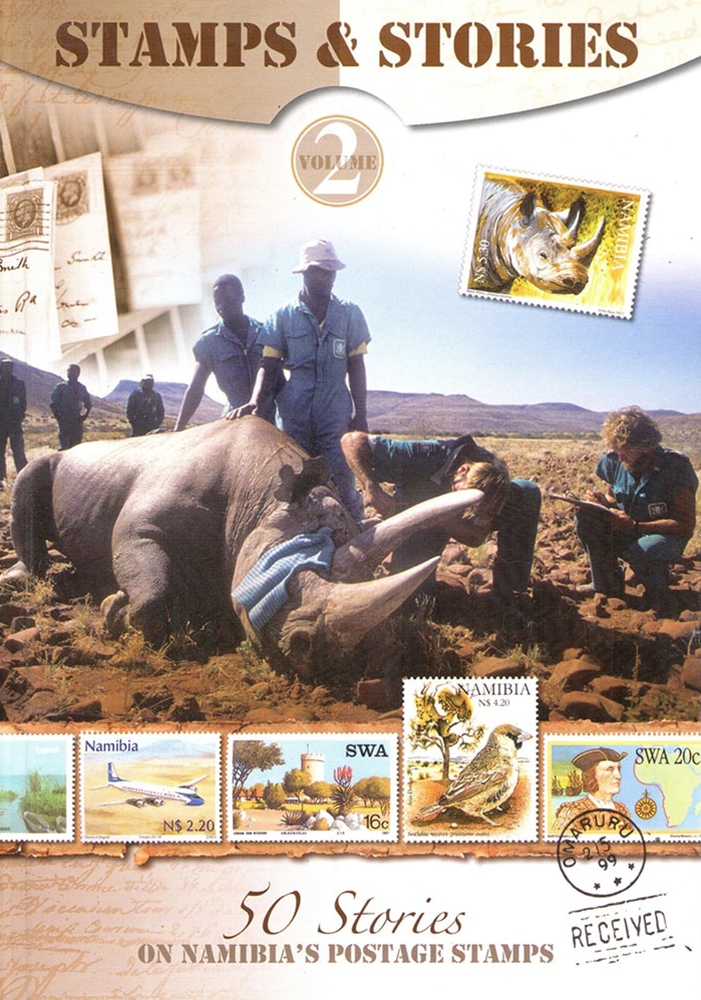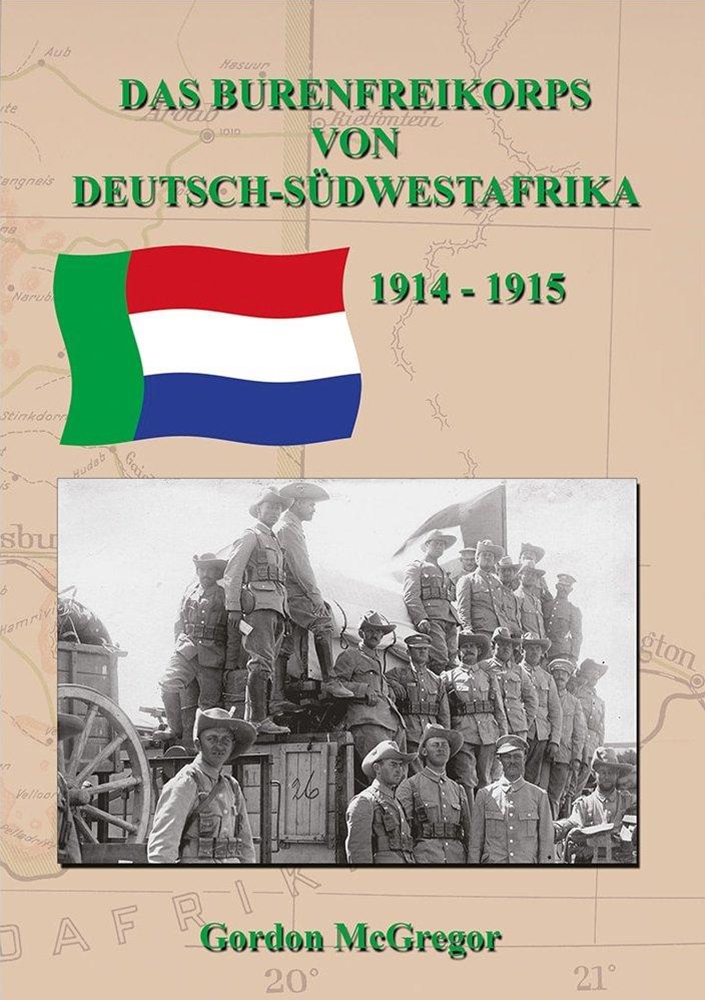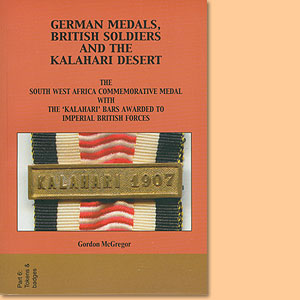The First World War in Namibia August 1914 - July 1915, by Gordon McGregor and Mannfred Goldbeck

The First World War in Namibia August 1914 - July 1915, by Gordon McGregor and Mannfred Goldbeck. Gondwana Publishers. Windhoek, Namibia 2014. ISBN 9789991689647 / ISBN 978-99916-896-4-7
You may be wondering why Gordon McGregor and Mannfred Goldbeck have produced this book marking the hundredth anniversary of The First World War in Namibia August 1914 - July 1915, then German South West Africa. The Great War or the First World War, as it later became known, continues to cast an immense shadow on us today, its course and effects having played a large part in shaping the world as we know it.
Gordon McGregor Mannfred Goldbeck
As one of the countries outside of Europe that was drawn into the war, inadvertently embroiled in the unique situation that was transpiring in the Union of South Africa, the country that was to invade and occupy German South West Africa, Namibia's history warrants inclusion in the worldwide WWI centenary commemorations. This book is our contribution. The unique situation referred to here was the contentious Boer Rebellion. This rebellion was intended to halt the invasion of German South West Africa by the newly formed Union Defence Force, forcing the South African government to concentrate on suppressing the uprising. The cause of this rebellion, in essence, was the feeling amongst the Boer population that it was inappropriate for the South African government to order the invasion of German South West Africa in support of their old enemy, Great Britain. It was only twelve years before the outbreak of the war when the Boer republics had been forced to surrender to Great Britain at the conclusion of the Anglo-Boer War of 1899-1902, giving up their cherished independence. The majority of Boers felt that this was now the time to rise up against the British and regain their hard-won independence while they were engaged in a war in Europe. The invasion of the German colony was also seen as an affront against Germany, a country that had supported the Boers during their war against Great Britain. This book does not give intricate detail of the campaign in German South West Africa, which has been well-documented in the past. Rather, it endeavours to give a comprehensive view of what it was like within the country and touches on various aspects of the campaign that are not generally dealt with in classic history books. We hope that our readers will find the material as fascinating as we do. After Great Britain had declared war on Germany on 4 August 1914, General Louis Botha, Prime Minister of the Union of South Africa, sent a telegram to the British Government on 7 August in which he offered to extend help to Great Britain. In this telegram, he stated that the South African Government was willing to deploy the newly formed Union Defence Force (UDF) for the performance of the duties entrusted to the Imperial Troops stationed by Great Britain within in the Union of South Africa. The object of the South African Government's offer was of course, to release these Imperial Troops for military service elsewhere by Great Britain. On the same day, the British Government accepted the offer and added, "If your Ministers at the same time desire and feel themselves able to seize such part of German South West Africa as will give them command of Swakopmund, Luderitzbucht and the wireless stations there, or in the interior, we should feel that this would be viewed as an act of great and urgent Imperial Service". The South African Government agreed to this on 10 August, thus effectively setting the stage for the invasion of German South West Africa. The German government did not anticipate that the colony of German South West Africa or in fact any of her colonies would become involved in the military conflict that was in essence a European war. [...]
This is an excerpt from The First World War in Namibia August 1914 - July 1915, by Gordon McGregor and Mannfred Goldbeck.
Title: The First World War in Namibia August 1914 - July 1915
Authors: Gordon McGregor; Mannfred Goldbeck
Series: Gondwana History
Publisher: Gondwana Publishers
Windhoek, Namibia 2014
ISBN 9789991689647 / ISBN 978-99916-896-4-7
Softcover, 17 x 24 cm, 364 pages, numerous b/w photos and battle map sketches
McGregor, Gordon und Goldbeck, Mannfred im Namibiana-Buchangebot
The First World War in Namibia August 1914 - July 1915
This book commemorates the 100th Anniversary of the beginning of the First World War in Namibia August 1914 - July 1915.
Stamps & Stories: 50 Stories of Namibia's Postage Stamps Vol 2
Stamps & Stories: 50 Stories of Namibia's Postage Stamps Vol 2 contains entertaining stories related to the images on Namibian postage stamps.
Stamps & Stories: 50 Stories of Namibia's Postage Stamps Vol 1
Stamps & Stories: 50 Stories of Namibia's Postage Stamps Vol 1 introduces to the postal history of Namibia.
Die Kulturgruppen in Namibias östlicher Sambesi-Region (Ost-Caprivi)
Die Kulturgruppen in Namibias östlicher Sambesi-Region (Ost-Caprivi): Eine historische Perspektive und ein Kapitel über Baobabs.
Gondwana History: Memorable Moments from Namibia's Past, 4th edition
Gondwana History: Memorable Moments from Namibia's Past, 4th edition, is a collection of 30 tales of Namibian history, culture and nature.
Gondwana History: Memorable Moments from Namibia's Past, 2nd edition
This is the 2nd edition of Gondwana History with thirty memorable moments from Namibia's past times.
Gondwana History: Memorable Moments from Namibia's Past, 1st edition
This is the 1st edition/volume of the history series Gondwana History: Memorable Moments from Namibia's Past.
David Levin of Twyfelfontein
David Levin of Twyfelfontein is a nice book on Namibian local history and a farmer's biography.
The People of Namibia's Eastern Zambezi Region (Eastern Caprivi)
This series introduces to history, tribes and culture of the people of Namibia's Eastern Zambezi Region, the former Eastern Caprivi.
David Levin auf Twyfelfontein
David Levin (1911-1983) war der erste und letzte weiße Farmer auf Twyfelfontein. Dies ist ein interessantes ortsgeschichtliches und biographisches Buch.
Gondwana History. Momentaufnahmen aus der Vergangenheit Namibias, Band 4
Auch der vierte Band der Reihe Gondwana History fesselt mit zahlreichen kurzen Berichten und Momentaufnahmen aus der Vergangenheit Namibias.
Gondwana History. Momentaufnahmen aus der Vergangenheit Namibias, Band 2
Band 2 aus der Reihe Gondwana History bietet 25 Geschichte als Momentaufnahmen aus der Vergangenheit Namibias.
Wilde Pferde in der Namibwüste
Wilde Pferde in der Namibwüste ist eine Pferde-Biographie, die bei den frühen Equus-Gruppen ansetzt und ihre Verbreitung südlich der Sahara und insbesondere nach Namibia untersucht.
Wild horses in the Namib Desert
This is a comprehensive book on the wild horses living in the Namib Desert in south-western Namibia.
Gondwana History. Momentaufnahmen aus der Vergangenheit Namibias, Band 1
Die Buchreihe Gondwana History ist eine kurzweilige Sammlung interessanter Momentaufnahmen aus der Vergangenheit Namibias.
The History of Freemasony in Namibia 1905-2019
The History of Freemasony and of the various Lodges and Chapters in Namibia 1905-2019.
South West African Wheel Tax Badges 1926-1961
The wheel tax metal badge came into existence as a result of Ordinance No. 6 of 1926 of the South West Africa Administration. The last badge was issued in 1961.
The Merit Medal for Combatants in German South West Africa 1892-1918
The Merit Medal for Combatants in German South West Africa 1892-1918 was awarded to members of the native population.
Gondwana History: Memorable Moments from Namibia's Past, 6th edition
Gondwana History: Memorable Moments from Namibia's Past, 6th edition, is a collection of 30 tales of Namibian history, culture and nature.
Gondwana History: Memorable Moments from Namibia's Past, 3rd edition
Gondwana History: Memorable Moments from Namibia's Past, 3rd edition, is a collection of 30 tales of Namibian history, culture and nature.
Orden- und Medaillenverleihung für den Feldzug in Deutsch-Südwestafrika 1914-1915
Endlich eine vollständige Namesliste für die Orden- und Medaillenverleihung für den Feldzug in Deutsch-Südwestafrika 1914-1915!
The Equestrian Monument (Reiterdenkmal) 1912-2014
A chronological documentation of reports, newspaper clippings and photos/illustrations related to the Equestrian Monument (Reiterdenkmal) 1912-2014.
Seekrieg in Angra Pequena
Dieses hochinteressante Buch erzählt die wahre Geschichte über den sogenannten Seekrieg in Angra Pequeña (Lüderitzbucht) und was sich 1863 dort tatsächlich zugetragen hat.
Das Reiterdenkmal 1912-2014
Diese chronologische Dokumentation zeigt anhand von Berichten, Artikeln und Fotos die Ereignisse um das Reiterdenkmal in Windhoek, Namibia, im Zeitraum von 1912 bis 2014.
Die Eingeborenen-Passmarken von Deutsch-Südwestafrika
Dieses Standardwerk bietet einen Überblick über die Eingeborenen-Passmarken, die in der Kolonie Deutsch-Südwestafrika verwendet wurden.
Gondwana History. Momentaufnahmen aus der Vergangenheit Namibias, Band 3
Dies ist der Band 3 aus der Reihe Gondwana History mit weiteren Momentaufnahmen aus der Vergangenheit Namibias.
Murder at Angra Pequeña
Murder at Angra Pequeña is the true story of an incident that happened in 1863 in South West Africa.
Das Burenfreikorps von Deutsch-Südwestafrika 1914-1915
Das Burenfreikorps von Deutsch-Südwestafrika 1914-1915: Aktivitäten von der Aufstellung des Burenfreikorps bis zu dessen Auflösung.
German Medals, British Soldiers and the Kalahari Desert
The South West Africa Commemorative Medal with the "Kalahari" Bars awarded to The Imperial British Forces
For Valour. The history of the Iron Cross and Wound Badge in German Southwest Africa 1914-1918
For Valour. The history of the Iron Cross and Wound Badge in German Southwest Africa 1914-1918.
The Prisoner of War Tokens of German South West Africa
The Prisoner of War Tokens of German South West Africa: A description and a historical view.
Die Kriegsgefangenenmarken von Deutsch-Südwestafrika
Eine sehr interessante Beschreibung der Kriegsgefangenenmarken von Deutsch-Südwestafrika mit geschichtlichem Abriß.
Keine Chance: Der Erste Weltkrieg in Namibia August 1914 - Juli 1915
Der Haupttitel 'Keine Chance' steht für die Lage der Schutztruppe in Namibia während des Ersten Weltkrieges von August 1914 bis Juli 1915.

































